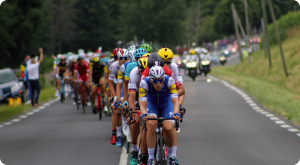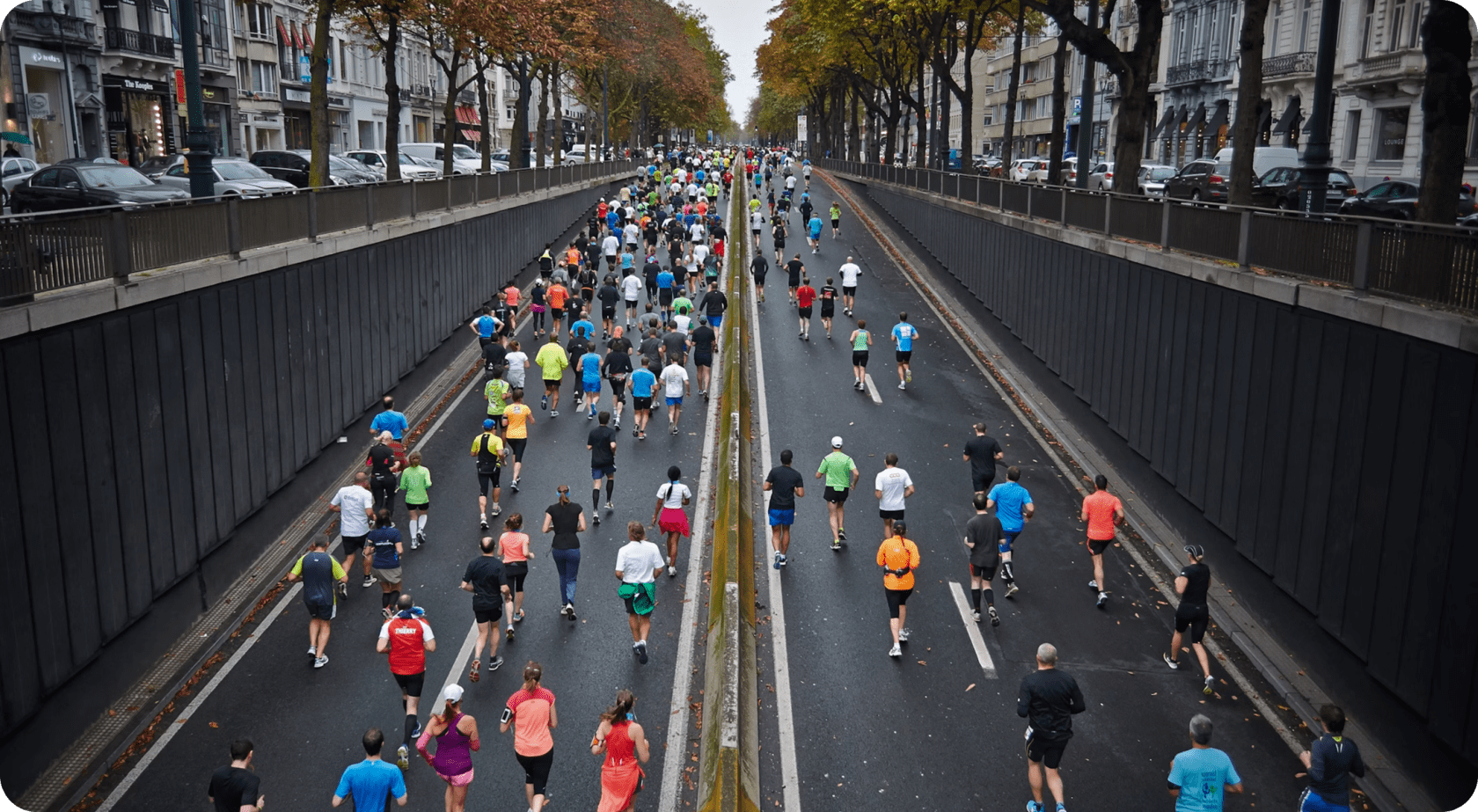You signed up for your first half-distance Ironman triathlon.
You have probably finished a sprint triathlon or an Olympic distance race, but you don’t know where to start with your triathlon training plan.
You hear everything, and then it’s opposite online, and now you are just confused.
I’ve been there too.
Half Ironman is long and challenging, so it’s important to be prepared.
In this article, I’ll provide essential information on training, key workouts to cover, how to create the ultimate half Ironman training plan that works for you, and some tips on mental preparation.
And if you are just entering the Ironman world and wonder how to train for an Ironman while working full time, you should read this post, where you can find pieces of advice on juggling work, family, and training.
Let’s go!
Half Ironman Distance and Requirements
A 70.3 distance triathlon is one of the types of triathlons, and it is named after the total number of miles you cover during the race:
- 1.2 miles of swimming
- 56 miles of cycling
- 13.1 miles of running
This is half the distance of a full Ironman (check out this Ironman training plan to see if you are ready for the big race), so it is considered a middle-distance triathlon.
Half Ironman races are extremely popular because the 70.3 distance offers both a physical and mental challenge.
Yet, the training can still be balanced and managed alongside work, family, and social commitments (with some careful planning).
The official cut-off time is eight hours, and for most triathletes in their age group, finishing the race takes about six hours.
It is still a lot of time to be on the race course, so without a proper training plan, it would be hard to reach that finish line.
How to Create a 70.3 Training Plan
A half Ironman triathlon training plan needs to be structured in a way that builds endurance, strength, and race-specific speed while avoiding injury or burnout.
The plan is usually divided into three phases: base, build, and taper, with training spread over 16 to 24 weeks.
Step 1: Identify Your Current Fitness Level
Before jumping into training, it’s important to assess your current fitness level.
The best way to do this is through simple tests in each discipline.
Swim Test
- Perform a 400m and 1,000m time trial at your best effort.
- Use your pace per 100m as a reference for training sessions.
Bike Test
- Do a 20-minute all-out effort on a flat course or indoor trainer.
- Calculate your Functional Threshold Power (FTP) by multiplying your average power by 0.95. Learn how to prepare for the FTP test.
- If you don’t have a power meter, use heart rate: Take 95% of your average heart rate during the test as your threshold heart rate.
Run Test
- Perform a 30-minute time trial at your best sustainable effort.
- Use your average pace per kilometer as a reference for threshold sessions.
- Alternatively, take your average heart rate in the last 20 minutes as your threshold HR.
With these results, you can define your training zones to ensure you’re working at the right intensity in each session.
Step 2: Structure Your 70.3 Training Plan
A 70.3 training plan follows three main phases: the base phase, the build phase, and the taper phase.
Each phase serves a specific purpose in preparing your body for race day.
Base Phase (6–10 weeks)
This phase focuses on building a strong aerobic foundation.
The goal is to improve endurance and overall strength while avoiding excessive fatigue.
Training intensity is mostly low to moderate, which allows your body to adapt without too much stress.
- Endurance sessions: long, steady swimming workouts, cycling, and running sessions aimed at improving aerobic capacity.
- Strength training: core exercises, weight training, or Pilates to build muscular endurance and prevent injuries.
- Skill work: drills in swimming for better technique, low-cadence cycling for strength, and running form improvements.
This phase is essential because a strong base supports more intense training later.
Beginners may spend more time here, while experienced athletes might move through it faster.
Build Phase (6–8 weeks)
During this phase, training volume and intensity increase to prepare your body for race conditions.
At this point, workouts become more structured, incorporating speed, strength, and endurance.
- Interval training: short, intense efforts in cycling and running to boost power and speed. Example: 3–8 minutes VO2 max intervals on the bike, track sessions with 800m or 1k repeats in running.
- Brick sessions: running immediately after cycling to train the body for race-day transitions.
- Race-pace efforts: swimming, cycling, and running at race intensity to simulate the demands of a 70.3.
This phase pushes your limits, but recovery is crucial.
Make sure you schedule easy days between hard workouts to ensure proper adaptation and prevent overtraining.
Taper Phase (2–3 weeks)
The taper is when you reduce training volume while keeping some intensity.
The goal is to let the body recover and be fresh for race day without losing fitness. Wondering if it is a good idea to train the day before a triathlon? Find out the answer in our recent blog.
- Shorter workouts: sessions become shorter, but some high-intensity efforts remain to maintain sharpness.
- Increased rest: more recovery days to let the body absorb the training load.
- Race-specific preparation: practicing transitions, as this is the fourth discipline in triathlon, open-water swimming, and pacing strategies.
During taper, it’s also important to focus on nutrition, hydration, and sleep to arrive at race day feeling strong and ready. If you are getting ready for the marathon, check out this guide on how to taper a marathon.
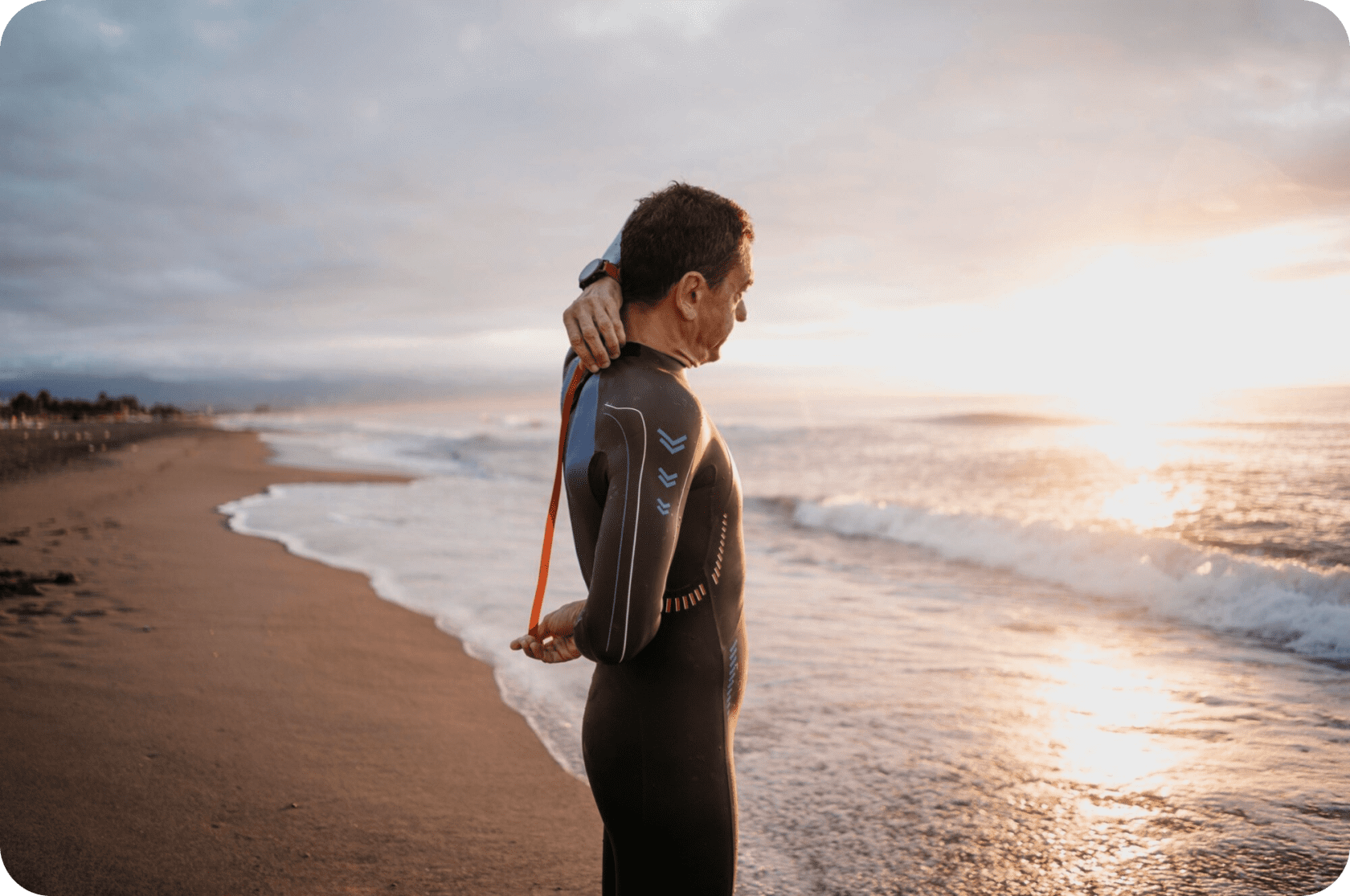
Key Components of a Half Ironman Training Plan
If you are somebody who is aiming to complete their first Ironman 70.3, then your main goal is to do enough training so you can have a successful finish. By the way, here is my recent Ironman 70.3 race recap, which was a tough one, but a definitely rewarding experience.
With that in mind, I would recommend starting out with at least 6-7 hours of training per week and this can build up to a peak training each week of 10-11 hours.
Split this time up into two to 2-3 swim sessions, three rides, and three run sessions each week.
In terms of training, you want to be able to gradually increase the training volume over time.
Ideally, you want to split this up into blocks of training. So, think about 4-6 week blocks where you build your volume over the first weeks, and then the final (fourth week of sixth week) of each block can be a nice and easy recovery week.
In terms of how soon you should start your half-Ironman training journey, it is recommended to start at least four months before the event, or in other words, 16 weeks.
But, essentially, the sooner you get started, the better results you can get.
You can create your training plan on your own, using the recommendations provided here, but if it is possible, you can also reach out to professional coaching services for a more tailored approach.
Sample Half Ironman Training Plan Weeks
A well-balanced Half Ironman training program includes structured swim, bike, and run workouts, along with strength training, mobility exercises, and rest.
The key is progressive overload, meaning your training should gradually become more challenging to allow your body to adapt and get stronger.
A typical week in your training plan will have 2–3 swim workouts, 3 bike rides, and 3 runs.
The structure depends on which phase of training you’re in, but every week should have a mix of endurance work, intensity, and recovery.
Base Phase (Weeks 1–6) – Focus on Endurance and Strength
Mostly easy, steady sessions with some strength work.
Week 1
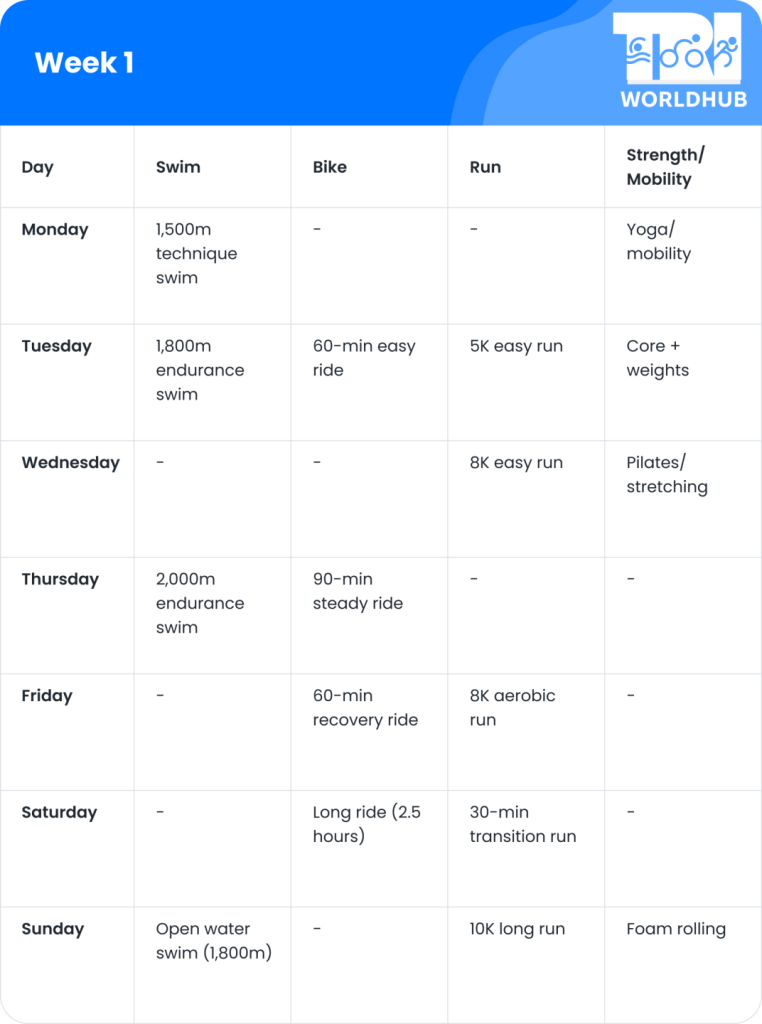
Week 2-3
- Increase bike and run duration slightly
- Swim volume stays consistent
- Strength training 2x per week
Week 4 (Recovery Week)
- Reduce volume by 30%
- No intensity sessions
Week 5-6
- Long ride increases to 3+ hours
- Run distance increases to 12-14K
Build Phase (Weeks 7–12) – Increase Intensity and Race Simulation
Introduce interval sessions for speed and stamina.
Week 7
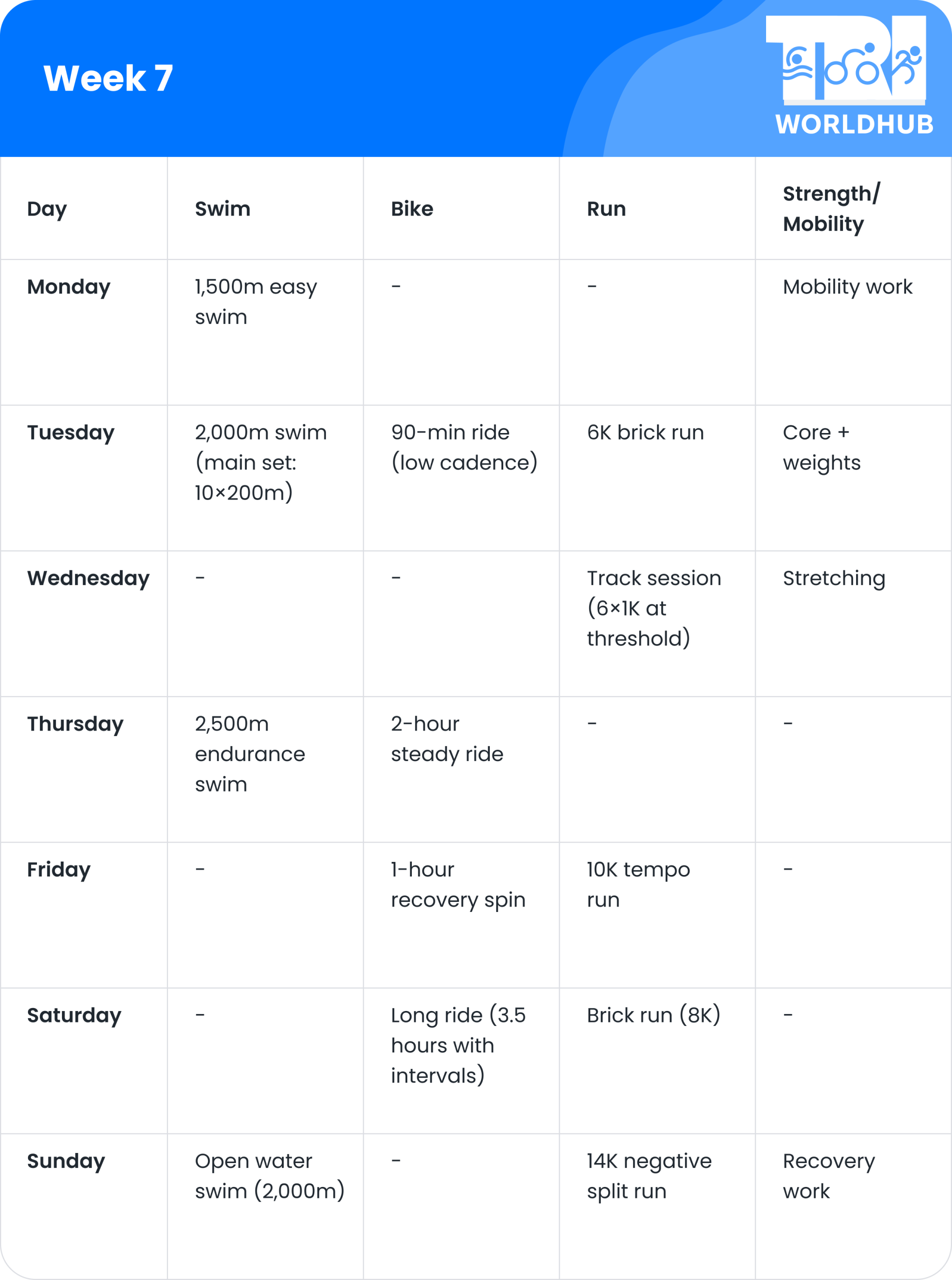
Week 8-9
- Increase VO2 max bike intervals (5×4 minutes hard efforts)
- Swim sessions include fast reps with paddles
- Run intensity increases (threshold intervals)
Week 10 (Recovery Week)
- Reduce intensity, maintain training consistency
Week 11-12
- Long ride reaches 4 hours
- Run up to 16K at tempo effort
- Introduce race-pace efforts (20K TT on bike, 10K tempo run). Introduce short brick runs.
Peak & Taper Phase (13–18) Sharpen Fitness & Race Day Recovery
Cut volume but keep some intensity to stay sharp.
Week 13-14
- Brick workouts: 2.5-hour bike + 10K run
- Race simulations: Swim + bike + run in one session
- Open water swim focus
Week 15-16 (Taper Begins)
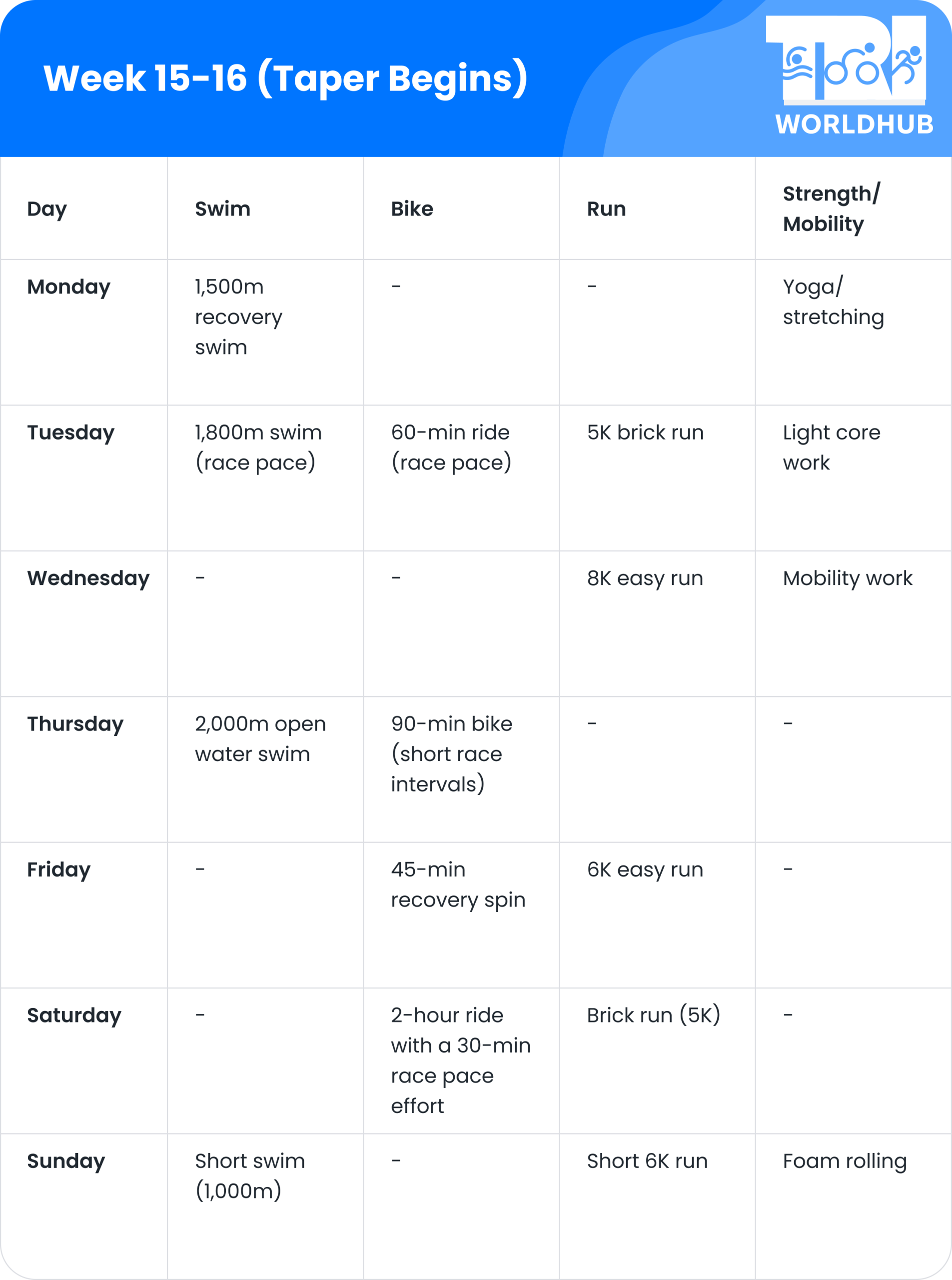
Week 17-18 (Race Week!)
- Reduce training by 50%
- Race simulation swim + bike (short, not exhausting)
- Two short race-pace efforts (10K ride + 3K run)
- Taper focus: Eat well, sleep, reduce stress
This training plan is focused on building endurance, as it adds intensity gradually and ensures proper tapering before race day.
Feel free to contact me for a more personalized training approach and the best practices for improving your training plan.
Tips for a Successful First Half Ironman
Getting ready for your first half Ironman race is not just about endurance training.
Well, of course, endurance training is important, but preparing for the race is also about strategy, consistency, and smart recovery.
Here are a few tips that will, hopefully, help you nail your 70.3 training plan:
- Start training at least six months in advance, especially if you’re new to longer endurance events. This gives your body enough time to build the necessary endurance and strength while reducing the risk of injury.
- Your training plan should include a mix of swim, bike, and run sessions, along with strength training to improve stability and prevent muscle imbalances.
- Recovery is just as important as training.
- Incorporate rest days, mobility work, and stretching to keep your body functioning well.
- Nutrition and hydration planning should start early in your training, not just in the weeks leading up to race day.
- Practice fueling strategies during long workouts to see what works best for your stomach and energy levels. Aim for a mix of carbohydrates, electrolytes, and hydration to sustain effort without hitting the dreaded “wall.”
- Pacing is key. The Half Ironman is a long race, and going too hard early can make the run miserable. Focus on even effort, keeping the swim controlled, the bike smooth but strong, and the run steady.
- Negative splitting — starting conservatively and finishing stronger — can make a big difference in how you feel at the finish line.
- Finally, simulate race conditions as much as possible in training. Open-water swims, long brick workouts, and practicing transitions will help you feel more comfortable on race day.
If you are training indoors, feel free to explore this ultimate indoor triathlon training plan, which you can customize to fit your needs and goals.
Overall, the more prepared you are, the more enjoyable and successful your first Half Ironman will be.
However, training for a half Ironman triathlon is not as straightforward as it might seem. Especially if you are doing it for the first time.
Let’s explore the common mistakes when it comes to training for a middle-distance triathlon.
Common Mistakes Athletes Make During Half Ironman Training
Let me walk you through some of the most common mistakes and how you can avoid them to set yourself up for success.
One of the biggest mistakes I see is neglecting consistency
It might feel like you’re too busy or life gets in the way, but skipping workouts early on can really add up.
Imagine building a house: if you skip a few days of work, the foundation isn’t as solid, and that can cause problems down the road.
It’s the same with training for a race like the Half Ironman. If you miss those long bike rides or run sessions early on, it’s much harder to build the endurance you need when race day comes.
The key is gradual progress — keeping a steady pace with your training so your body adapts properly.
Another mistake many of us make is overtraining
It’s tempting to think that if we just push harder every day, we’ll perform better.
But here’s the thing: your body doesn’t get stronger during the workout; it gets stronger while resting and recovering.
Rest days are when your muscles repair and grow. I’ve fallen into this trap myself, and let me tell you, it never ends well.
Lack of sleep and no recovery days, or ignoring the need for rest, can quickly lead to burnout.
Research on recovery and performance in sports shows that athletes who prioritize recovery have better overall performance in the long run, and I can personally vouch for that.
The Recovery Pyramid is a simple way to think about how athletes can recover properly. It breaks down recovery into three levels: the basics like sleep and nutrition, active methods like stretching and massage, and advanced treatments like cryotherapy.
Depending on where you are in your training or how close you are to a competition, you can focus more on one type of recovery over another, but it all works together to keep you feeling strong and ready to perform.

Another mistake that is pretty common is neglecting strength and conditioning.
Strength training and mobility work often get pushed to the back burner in triathlon training, but they’re key to preventing injuries and improving performance.
In my experience, paying attention to your core, legs, and upper body helps you avoid those annoying aches and pains that can derail your training.
I know it’s easy to skip strength workouts when you’re focused on those three disciplines (swim, bike, and run), but those extra sessions are worth it.
Strengthening muscles that aren’t used as much during endurance activities (like your shoulders for swimming or your glutes for cycling) can prevent muscle imbalances.
Plus, a strong body helps you move more efficiently, which can shave valuable seconds off your race times.
Pacing is another area where it’s easy to make mistakes
In the excitement of race day, it’s easy to push too hard on the bike and then pay the price on the run.
I learned this the hard way after going out too fast on the bike and then feeling like I had nothing left for the run.
The thing is, if you start too fast, you burn through your energy stores way too quickly.
Starting with a steady, controlled effort and then gradually picking up the pace helps you sustain your energy throughout the race.
Another mistake I’ve seen, and made myself, is not practicing nutrition properly during training.
Nutrition plays a huge role in endurance sports. When I first started, I thought I could just grab whatever was available on race day, but that led to stomach issues and poor performance.
During your long training sessions, it’s essential to test different types of fuel to see what works best for your body. Whether it’s gels, bars, or electrolyte drinks, find out what sits well with you before the big day.
Studies back this up — athletes who practice their nutrition plan during long workouts have far fewer problems with GI distress during the race.
Finally, don’t forget about open-water swim practice
Pool swimming is great for training swimming technique and calculating your SWOLF swimming score, but the open water is a whole different beast.
Getting out there and practicing in similar conditions to race day is crucial.
Your sighting, breathing, and handling the waves all need to be on point.
It’s nerve-wracking at first, but once you get the hang of it, you’ll feel a lot more confident when it’s time to race.
These mistakes are common, but they can easily be avoided with a little awareness.
Stay consistent with your training, prioritize recovery, incorporate strength work, practice proper pacing, test your nutrition plan, and get comfortable with open-water swims.
This might sound like a lot, but with a little bit of effort, everything is possible.
If you want a personalized 70.3 training plan, feel free to reach out or join our global triathlete platform and let’s crack it together!
